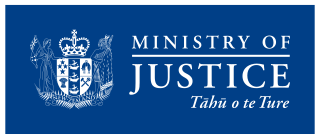
Eastbourne is a suburb of Lower Hutt, a part of Wellington, New Zealand. Lying beside the sea, it is a popular local tourist destination via car from Petone or from ferry crossings from central Wellington. An outer suburb, it lies on the eastern shore of Wellington Harbour, five kilometres south of the main Lower Hutt urban area and directly across the harbour from the Miramar Peninsula in Wellington city. A narrow exposed coastal road connects it with the rest of Lower Hutt via the Eastern Bays and the industrial suburb of Seaview. It is named for Eastbourne in England, another seaside town known as a destination for day-trips.
Archives New Zealand is New Zealand's national archive and the official guardian of its public archives. As the government's recordkeeping authority, it administers the Public Records Act 2005 and promotes good information management throughout government.
The Department of Internal Affairs (DIA) is the public service department of New Zealand charged with issuing passports; administering applications for citizenship and lottery grants; enforcing censorship and gambling laws; registering births, deaths, marriages and civil unions; supplying support services to ministers; and advising the government on a range of relevant policies and issues.

The Cabinet of New Zealand is the New Zealand Government's body of senior ministers, accountable to the New Zealand Parliament. Cabinet meetings, chaired by the prime minister, occur once a week; in them, vital issues are discussed and government policy is formulated. Cabinet is also composed of a number of committees focused on specific areas of governance and policy. Though not established by any statute, Cabinet wields significant power within the New Zealand political system, with nearly all government bills it introduces in Parliament being enacted.

The Ministry of Health is the public service department of New Zealand responsible for healthcare in New Zealand. It came into existence in its current form in 1993.
Te Manatū WakaMinistry of Transport is the public service department of New Zealand charged with advising the New Zealand Government on transport policy. The Ministry works closely with other government transport partners, including the New Zealand Transport Agency (NZTA) to advance their strategic objectives.
The Department of the Prime Minister and Cabinet (DPMC) is the central public service department of New Zealand charged with providing support and advice to the governor-general, the prime minister and members of the Cabinet of New Zealand. The department is also charged with centrally leading New Zealand's "national security planning, which includes civil defence."

The New Zealand Government is the central government through which political authority is exercised in New Zealand. As in most other parliamentary democracies, the term "Government" refers chiefly to the executive branch, and more specifically to the collective ministry directing the executive. Based on the principle of responsible government, it operates within the framework that "the [King] reigns, but the government rules, so long as it has the support of the House of Representatives". The Cabinet Manual describes the main laws, rules and conventions affecting the conduct and operation of the Government.

The Ministry of Justice is an executive department of the New Zealand Government, responsible for supporting the judiciary and the administration of justice within New Zealand. It develops justice policy and provides advice to ministers, Cabinet, and other justice sector agencies. Its main functions are to help reduce crime and build safer communities; increase trust in the justice system; and maintain the integrity of New Zealand's consitutional arrangements.
Kāinga Ora, officially Kāinga Ora – Homes and Communities, is a Crown agency that provides rental housing for New Zealanders in need. It has Crown entity status under the Kāinga Ora–Homes and Communities Act 2019.

New Zealand has a unitary system of government in which the authority of the central government defines sub-national entities. Local government in New Zealand has only the powers conferred upon it by the New Zealand Parliament. Under the Local Government Act 2002, local authorities are responsible for enabling democratic local decision-making and promoting the social, economic, environmental, and cultural well-being of their communities, as well as more specific functions for which they have delegated authority.

The Ministry of Business, Innovation and Employment is the public service department of New Zealand charged with "delivering policy, services, advice and regulation" which contribute to New Zealand's economic productivity and business growth.

Auckland District Health Board (ADHB) was a district health board that provided healthcare in the Auckland Region in New Zealand, mainly on the Auckland isthmus. This district health board existed between 2001 and 2022 and was governed by a part-elected, part-appointed board. In 2022, its functions and responsibilities were subsumed by Te Whatu Ora and Te Aka Whai Ora.

The Canterbury District Health Board was a district health board with the focus on providing healthcare to the Canterbury region of New Zealand, north of the Rangitata River. It was responsible for roughly 579,000 residents, or 12% of New Zealand's population. The Canterbury District Health Board covered a territory of 26,881 square kilometers and was divided between six territorial local authorities. In July 2022, the Canterbury DHB was merged into the national health service Te Whatu Ora.
The COVID-19 pandemic in New Zealand was part of the pandemic of coronavirus disease 2019 caused by severe acute respiratory syndrome coronavirus 2. The first case of the disease in New Zealand was reported on 28 February 2020. The country recorded over 2,274,370 cases. Over 3,000 people died as a result of the pandemic, with cases recorded in all twenty district health board (DHB) areas. The pandemic first peaked in early April 2020, with 89 new cases recorded per day and 929 active cases. Cases peaked again in October 2021 with 134 new cases reported on 22 October.

The COVID-19 pandemic was confirmed to have reached Oceania on 25 January 2020 with the first confirmed case reported in Melbourne, Australia. The virus has spread to all sovereign states and territories in the region. Australia and New Zealand were praised for their handling of the pandemic in comparison to other Western nations, with New Zealand and each state in Australia wiping out all community transmission of the virus several times even after re-introduction in the community.

The COVID-19 pandemic in the Cook Islands is part of the ongoing worldwide pandemic of coronavirus disease 2019 caused by severe acute respiratory syndrome coronavirus 2. As of 30 October 2021, 12,841 first doses and 12,498 second doses of vaccine had been administered, which represents over 97% of the eligible population (12+) fully vaccinated.
A four-tier alert level restrictions system was in place in during the COVID-19 pandemic in New Zealand between March 2020 and December 2021, with levels 3 and 4 being forms of lockdown. In level 1 there were no restrictions; in level 2 there were limits on gatherings; in level 3 only purposeful travel was allowed and there were strict limits on gatherings; and in level 4 only essential travel was allowed and gatherings were banned.
Health New Zealand - Te Whatu Ora is the primary publically funded healthcare system of New Zealand. It was established by the New Zealand Government to replace the country's 20 district health boards (DHBs) on 1 July 2022. Te Whatu Ora is charged with working alongside the Public Health Agency and Te Aka Whai Ora to manage the provision of healthcare services in New Zealand. Margie Apa was appointed chief executive of Te Whatu Ora in December 2021.

The Pae Ora Act 2022 is a New Zealand Act of Parliament that replaces the district health board system with a national public health service called Health New Zealand. It also establishes a separate Māori Health Authority (MHA) and a new Public Health Agency. The bill passed its third reading on 7 June 2022 and became law on 14 June 2022.














